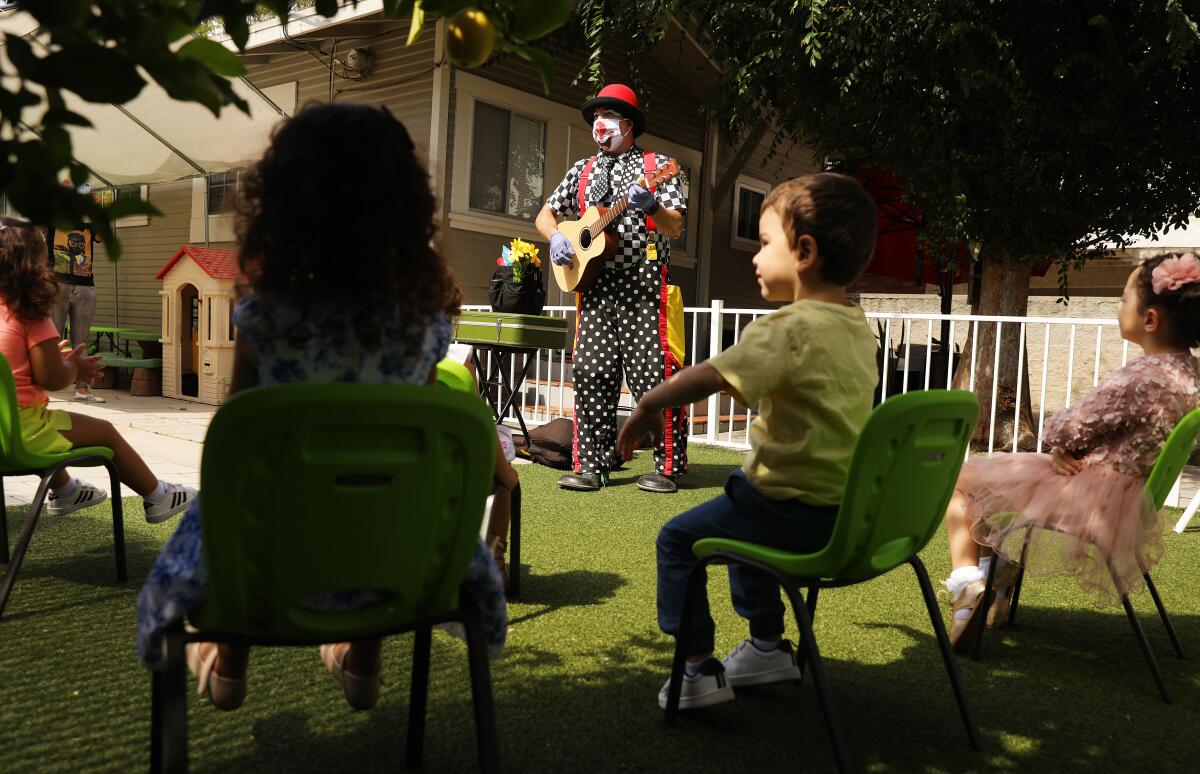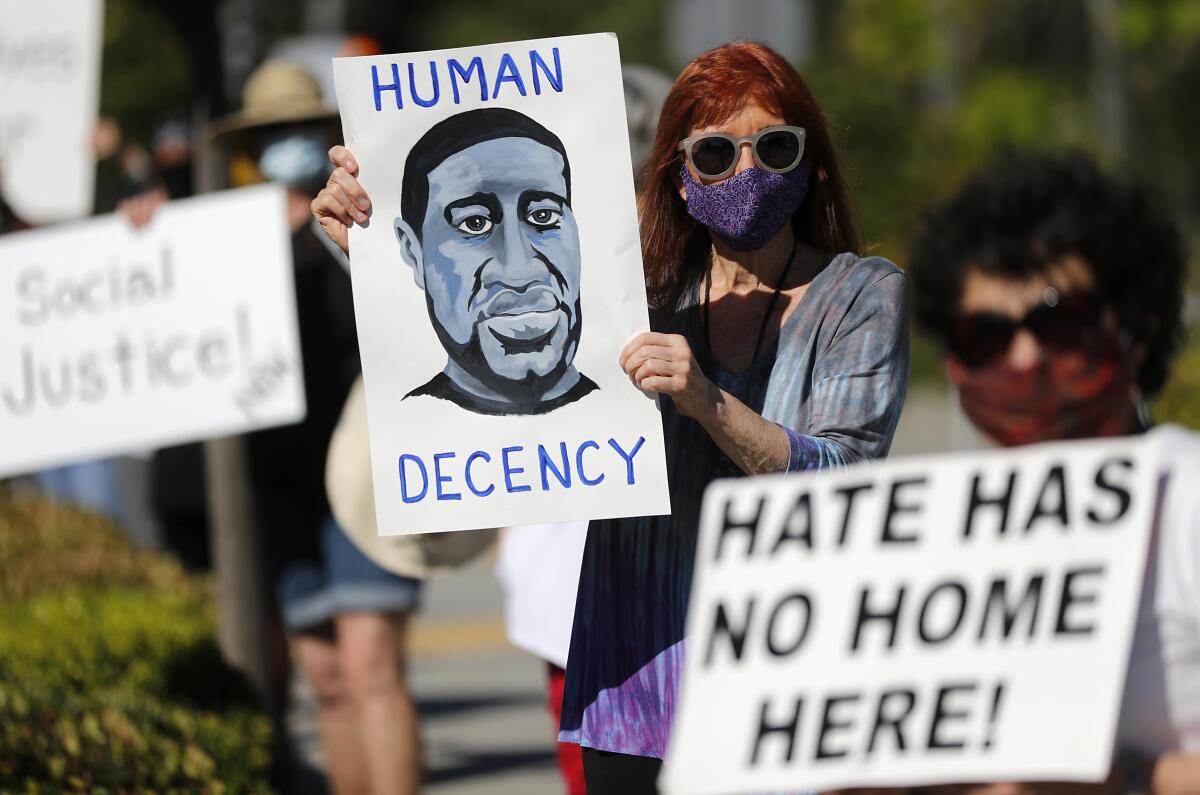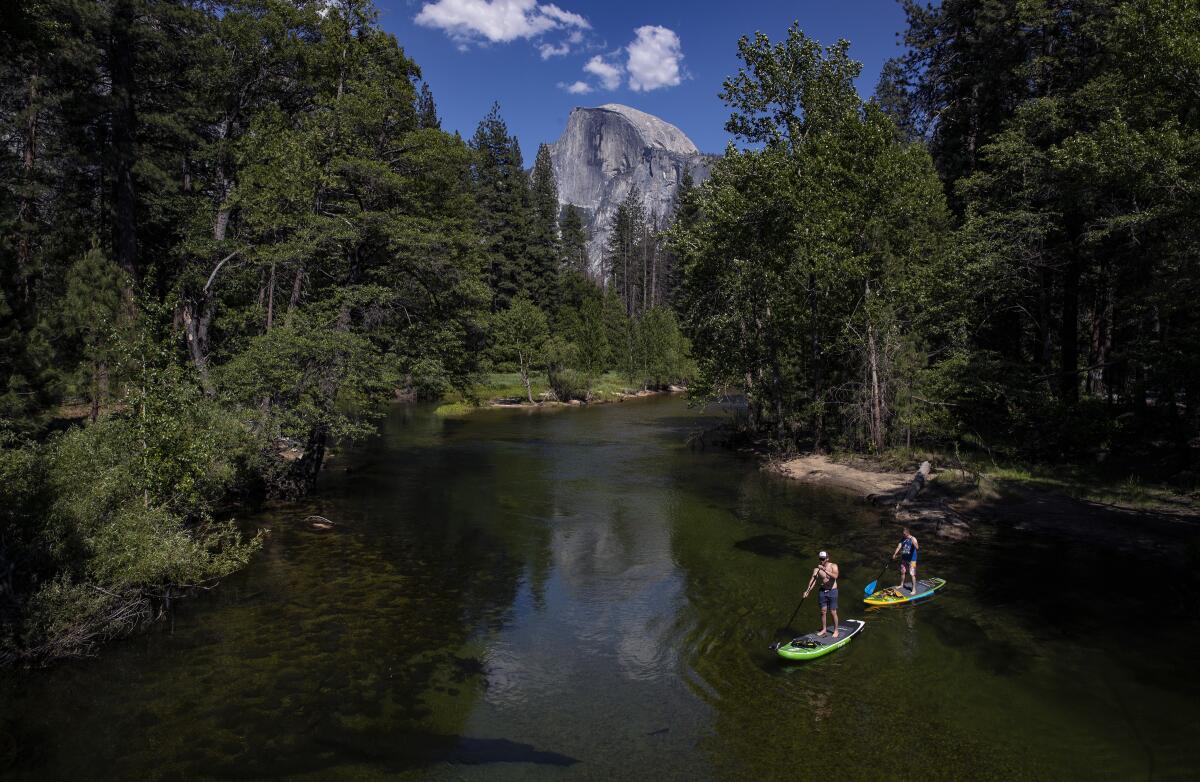Coronavirus Today: Visualizing our jobs crisis
Good evening. We’re Diya Chacko and Sam Schulz, and it’s Friday, June 19. Here’s the latest on what’s happening with the coronavirus, plus ways to spend your weekend and a look at some of the week’s best stories.
Three million Californians are collecting unemployment benefits, close to a quarter of a million new claims were filed last week, and more than 16% of the labor force is out of work. The state has begun to reopen, but the pandemic has devastated its economy. Since the unprecedented scale of the damage can be hard to comprehend, The Times is tracking the data with our interactive graphics by sector, county and company. (If you need to file for unemployment, you can consult our guide for assistance.)
Although the state’s unemployment rate fell slightly in May, it was still at 16.3% — dwarfing the 4.1% rate from that time last year and well above the recession-era peak of 12.3% a decade ago. Even as more businesses reopen and begin hiring again, for some restaurant workers it’s a lose-lose proposition: They can either return to jobs that are not much riskier than before, or risk losing unemployment benefits by refusing an offer.
As more businesses reopen, the state’s new mask rules will be key to reducing transmission of the virus, experts say — although whether they will be enforced remains an open question.
Riverside and San Bernardino counties both reported their highest ever one-day case jumps this week. There are also high numbers of new reported cases in Los Angeles County, where more than 3,000 people have died. But officials there say efforts to slow the outbreak’s spread appear to be working, as two key indicators remain relatively steady and average daily deaths have fallen.
In the global race for a vaccine, rich countries are rushing to place advance orders to guarantee their people are first in line, raising serious questions about where that will leave developing countries. Without a detailed strategy to ensure worldwide access, the allocation could be inequitable and very messy, experts say. Some countries have called for suspending intellectual property rights if there is an overwhelming need, but the industry‘s response has been lukewarm.
In some rich countries that have been hit hardest by the virus, like the United Kingdom, calls are growing louder every day for leaders to explain their actions, and inaction, on the pandemic. “I’m convinced that had the government taken a more proactive approach to protecting people, then not only would my dad still be here, but probably 20,000 more people who died,” said Matt Fowler, whose father died in March at the age of 56.
By the numbers
California cases and deaths as of 6:01 p.m. PDT Friday:

Track the latest numbers and how they break down in California with our graphics.
What to read this weekend
“I’ve never felt more needed at my job than right now,” said Karen Garcia, a nurse in Phoenix for whom the coronavirus pandemic felt like a call to duty. But as she tended to the gravely ill, her biggest fear wasn’t what the virus might do to her family — it was the Supreme Court. Garcia is protected from deportation by DACA, which the court shielded Thursday from the president’s plan to cancel it. “I’m just relieved the waiting is over and I can focus on my work,” Garcia said.
“Ghosted by Sacramento.” That’s how one California freelancer described his saga of filing for unemployment during the pandemic. “For weeks, I sent emails requesting an update or help. None of which elicited a response. I also blocked out four hours each workday in an attempt to get through to someone,” he wrote. It took months. “On Day 77, my quest came to an end, and the funds arrived.”
In 2005, no publisher wanted to touch Peter May’s pandemic thriller. “I was told by [the] literary establishment that it was a ludicrous idea to think that in modern times a capital city like London could be completely shut down by a virus,” he recalled. But once the coronavirus hit, they changed their tune, and now “Lockdown” has come to the U.S. under very different circumstances than May ever imagined.
Will kids understand jokes delivered through masks and magic tricks performed at a distance? Will they even want balloon animals if they have to be disinfected first? Such are the fears of a clown in the time of COVID-19. The pandemic has bloodied the fake noses of party clowns, even as it has opened new possibilities for medical clowns, who have taken to Zoom to bring whimsy to hospital patients.

“We go as Vegas goes.” The town of Baker, Calif., is a dot on the road between Los Angeles and Las Vegas, and its lifeblood is the weary or curious traveler coursing along Interstate 15. But when Vegas casinos reopened, any illusion that tourists would rush back evaporated.
In claiming disproportionate numbers of Black and Latino lives, the pandemic has helped force a national debate about structural racism — including in design and urban planning. So how do you build a city that is more equitable, where Black people can access public spaces without fear? The Times spoke with nine architects, planners and advocates for their ideas.
Orange County seniors are risking COVID-19 to protest in support of Black lives. The coronavirus is especially dangerous to the elderly, but for some protesters from the predominantly white retirement community of Laguna Woods, the idea of staying in lockdown while demonstrations shook the country went against their core beliefs.

One of Santa Barbara’s oldest streets is suddenly so popular it’s scary. In May, after two months of pandemic-related restrictions, the city turned about a mile of State Street into a pedestrian promenade, letting restaurants and bars add seating on sidewalks and in streets and parking lots. Will the experiment’s success spoil State Street? Officials acknowledged that it’s a work in progress.
The pandemic canceled prom, so we threw Los Angeles teenagers a virtual one. To be a high school senior during the pandemic has meant missing out on this time-honored tradition. So The Times asked students for photos in their prom getup. Here they are, along with a playlist and words of support from television stars.
Your support helps us deliver the news that matters most.
What to do this weekend
Learn more about Juneteenth. The holiday marks the day in 1865 when enslaved Black people in Texas, then the most remote region of the Confederacy, finally learned slavery had been abolished and they were free. It’s arguably as important a date as July 4. But it isn’t the only day on which Black Angelenos have historically celebrated emancipation. Gustavo Arellano took a look through historical archives and found that jubilees on other dates were a barometer of their times, too.
Then celebrate it. L.A. owes much of its Juneteenth tradition to a Texas transplant named Jonathan Leonard who kick-started the festivities in 1949 and later became synonymous with the annual feast of barbecue, red drink and watermelon in Leimert Park. If you’re quarantining, you can watch “Miss Juneteenth,” whose star Nicole Beharie spoke with The Times’ Sonaiya Kelley about her blacklisting and redemption. Justin Chang reviewed the film, and Mark Olsen wrote about it in his Indie Focus newsletter.
Make a doctor’s appointment. Really. Now more than ever, it’s crucial to stay healthy, and due to all the new safety protocols medical offices are taking, you’re unlikely to get sick from a routine visit. Read editor Stuart Leavenworth’s account of what his appointment was like for a sense of what to expect.
Get outdoors close to L.A. If you hit the trail, be sure to follow California’s new rules, plus our tips. If you’re going camping, consult our guide to what you need to know, from what’s changed to when you can go. You can sign up for our new newsletter the Wild for more.
Get a little salty — in your cooking, that is. Whether you’re going to whip up some radishes with sesame salt or salted chunky peanut butter cookies, make sure you know your salts and use the right one. Get more from our cooking team’s weekly newsletter.
Listen to a podcast. Try “Coronavirus in California” for dispatches from the front lines. If you’d rather take a mental break from the crisis, check out our new podcast “It Was Simple: The Betty Broderick Murders,” written and hosted by columnist Patt Morrison. Here are more great podcasts, too.
Resources
— Wash your hands for at least 20 seconds (here’s a super-fun how-to video), and keep your phone clean. Practice social distancing, maintaining six feet of space. And wear a mask if you leave home. Here’s how to do it right, and here are the rules around Southern California.
— Watch for symptoms like fever, cough, shortness of breath, chills, repeated shaking with chills, muscle pain, headache, sore throat and loss of taste or smell. If you think you might be infected, call your doctor or urgent care clinic before going.
— Here’s how to care for someone with COVID-19, from monitoring their symptoms to preventing the virus’ spread.
— If your job has been affected by the pandemic, here’s how to file for unemployment.
— We’ve got free resources for restaurant and entertainment industry workers having trouble making ends meet.
— Helping kids navigate pandemic life means being honest, acknowledging their feelings and sticking to a routine.
— In need of mental health services? Here are resources for coping during the crisis from the CDC and the L.A. County Department of Public Health. L.A. County residents can also call (800) 854-7771 or text “LA” to 741741. A pandemic in pictures

Got a question? Our reporters covering the coronavirus outbreak want to hear from you. Email us your questions, and we’ll do our best to answer them. You can find more answers in our Frequently Asked Questions roundup and in our reopening tracker.
For the most up-to-date coronavirus coverage from The Times over the weekend, visit our homepage and our Health section, listen to our “Coronavirus in California” podcast, sign up for our breaking news alerts, and follow us on Twitter and on Instagram.





